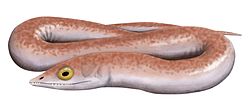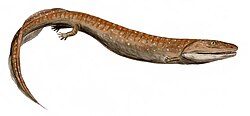| Obruchevichthys Temporal range: | |
|---|---|
| Scientific classification | |
| Kingdom: | Animalia |
| Phylum: | Chordata |
| Clade: | Sarcopterygii |
| Clade: | Tetrapodomorpha |
| Family: | † Elginerpetontidae |
| Genus: | † Obruchevichthys Vorobyeva, 1977 |
| Type species | |
| Obruchevichthys gracilis Vorobyeva, 1977 | |
Obruchevichthys is an extinct genus of stem-tetrapod from Latvia during the Late Devonian. When the jawbone, the only known fossil of this creature, was uncovered in Latvia, it was mistaken as a lobe-fin fish. However, when it was analyzed, it proved to hold many similarities to Elginerpeton , from Scotland. It was then declared belonging to the earliest group of tetrapods.





